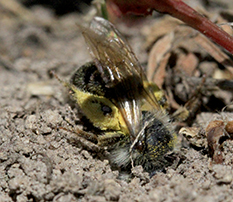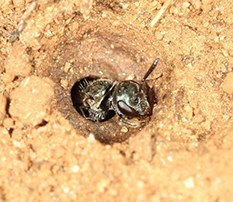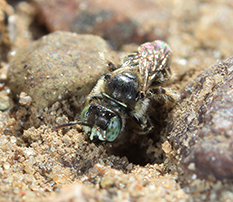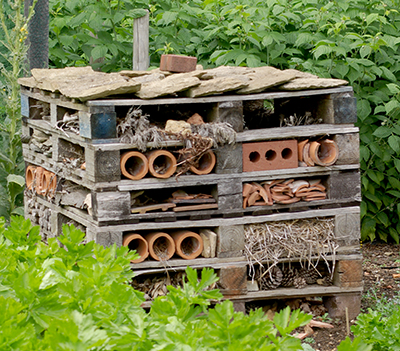
Smart Gardening: Invite pollinators by creating a smart habitat
DOWNLOADApril 5, 2016 - Rebecca Finneran and Abi Saeed
Smart gardeners know that bees, beneficial insects and spiders do their fair share of work in the garden. Pollinators such as bees and other beneficial insects can be encouraged to take up residence by adjusting a few of your gardening efforts that are bee-friendly and encourage a healthy habitat. By incorporating pollinator-friendly plants and reducing chemical applications, these hard-working creatures will naturally move in and provide numerous benefits such as pest control and pollination.
There are many ways to make your landscape more inviting and a sanctuary for bees. Native or wild bees nest in a variety of habitat types, depending on the species. However, most are ground nesting or cavity nesting.
Ground nesting: On solid ground
A majority of native bee species (approximately 70 percent) nest in the ground. Ground nesting bees, such as sweat bees, mining bees and bumble bees, like undisturbed areas of soil, sand and existing soil burrows for nesting. The soil they prefer varies by the type of bee, but if you leave patches of untreated, undisturbed earth, such as behind a garden shed or along a lightly used path, bees will find it and make themselves a home. Bare patches of soil don’t need to be unsightly. They can be simple, small and tucked away from plain sight.
“Bee” intentional about leaving patches of bare soil around raised beds and bunch-type grasses, like fescue, behind hedges and shrubs. The best places for these patches are in low traffic areas where soil compaction is limited. If you encourage pollinators to make their nests in out-of-the-way places, they are less likely to come into contact with humans.



Many native bee species nest in the ground. Photos by Jason Gibbs, MSU.
Cavity nesting: Buzz on Inn
Cavity nesting bees, such as mason bees, can reside in natural and artificial “nests.” Historically, these bees laid their eggs in old beetle burrows, twig bundles or ornamental grass stems. Due to meticulous management of lawns, shrubs and gardens, these resource types are fairly limited in urban areas. You can remedy that by building some bee-friendly nests to increase access to nesting locations.
There are many ways you can make “bee boxes” and “bug hotels” that would suit pollinators. Some can be as simple as drilling holes into untreated wood while others can be elaborate and decorative. The aesthetics of these nests are not important to bees, so they can be customized to your liking. Ready-made bug or bee hotels are available from commercial sources. It is important to consider some of these may not meet the necessary requirements for bees. The hole or tube needs to have a “blind” back (dead end) so it is protected on one end. It is also important to ensure you are using untreated wood.
Nest placement is vital to the health and survival of residing bees. Nests need to be placed in areas that are somewhat sheltered from harsh weather, birds and too much sunlight. You can also make them water-resistant by adding a small, sloping roof, or mount them under a garden structure or garage roof. If you are interested in housing and rearing some popular mason bee varieties like blue orchard bees, details about their specific nesting preferences can be found from a variety of resources. If you just want to increase available nesting habitat for visiting bees, you can create a bee hotel with different nesting structures, such as drilled wood, bamboo reeds, twigs and pinecones, which will appeal to a variety of bees. Bees and spiders alike will take up residence in a pile of old twigs and bricks.

What looks like a messy pile of bricks and twigs to us is an invitation for bees, spiders and other beneficials to take up residence. Photo by Rebecca Finneran, MSU Extension.
It is important to pay attention to chemicals used in and around your gardens. Over-spraying trees, shrubs or plants in bloom can result in chemical drift to unintended locations. Be cautious of this around pollinator plants and pollinator habitats. If possible, use pesticides and fertilizers away from plants and locations where bees have a higher likelihood of visiting and nesting. Never apply an insecticide to open flowers, even clover in lawns, and don’t apply a systemic insecticide to a plant that will bloom later in the growing season.
Hardscapes, like stones and concrete, are a great way to make your garden look unique and interesting, but don’t overdo it. Although mulch has several benefits in your garden, like moisture retention, cooling or heating soil and weed suppression, large quantities can prevent bees from accessing soil. If you plan on mulching around your raised beds or gardens, leave a few less visible sections mulch-free.
Although some people may find the idea of inviting and encouraging bees in a garden scary, keep in mind bees are not very imposing creatures. They mostly mind their own business, drawn by the food and habitat you have made available to them, and are not interested in bothering you. You are not likely to get stung unless you make an effort to do so. Native bees have been part of this landscape long before us, and we need to ensure they continue to be.
Increasing pollinator habitat does not need to be expensive or complicated. It can be as simple as you like and will have minimal impact on the appearance of your landscape. It is important to “bee” a good host for pollinators in your garden!
The importance of pollinators
Many of our fruit, vegetable and fiber crops require pollination by insects. These pollinators also pollinate more than 85% of the world’s flowering plants and are ultimately responsible for the seeds and fruits that humans, songbirds and even black bears consume. Since learning that the number of pollinators is significantly declining, many gardeners are learning how to make positive contributions towards their conservation. Understanding habitat needs and food sources while adjusting our garden maintenance routine is a step forward in pollinator conservation.
Many of us quickly think of the honey bee as a pollinator, but over 450 species of native bees live in Michigan. Native bees come in many shapes and sizes, and are often adapted to prefer native trees, shrubs and herbaceous plants, but will also work a widely diverse garden plant palette. Although bees are the most important pollinators, there are several other groups of insects, birds, mammals and even reptiles that play their part in pollinating specific plants.
Beneficial insects also make up the world’s hardest-working workforce by keeping pest insects in check. A diverse selection of native and non-native plants, judicious reduction of pesticide use and observant gardeners can form a successful strategy for preserving bees and other “good bugs” in our landscapes and gardens.
This work is supported by the Crop Protection and Pest Management Program 2017-70006-27175 from the USDA National Institute of Food and Agriculture. Any opinions, findings, conclusions or recommendations expressed in this publication are those of the author(s) and do not necessarily reflect the view of the U.S. Department of Agriculture.



 Print
Print Email
Email





